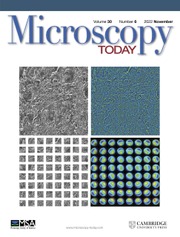Biological Applications
Label-Free Characterization of Collagen Crosslinking in Bone-Engineered Materials Using Nonlinear Optical Microscopy by Chao-Wei Hung, Nirmal Mazumder, Dan-Jae Lin, Wei-Liang Chen, Shih-Ting Lin, Ming-Che Chan, and Guan-Yu Zhuo, Microsc Microanal | doi: https://doi.org/10.1017/S1431927621000295
In this work, label-free nonlinear optical microscopy is used as a technique for rapid and routine testing of collagen scaffolds that can be used as biomaterial substrates in various biomedical applications. Among the test items, the crosslinking degree was found to be especially important as it influenced collagen properties. Therefore, second harmonic generation (SHG) and coherent anti-Stokes Raman scattering (CARS) microscopy is used in combination to explore the collagen structure at molecular and macromolecular scales (Figure). The crosslinking status can be analyzed from SHG images and presented as the coherency of collagen organization that can be correlated with the mechanical properties. Additionally, the comparative analyses of SHG signal and relative CARS signal of amide III band at 1240 cm−1 to δCH2 band at 1450 cm−1 of these scaffolds provide information about the variation of the molecular structure during a crosslinking process. The above measured parameters are verified by other conventional methods, thus serving as nonlinear optical signatures to indicate a successful crosslinking.

The merged image of SHG (blue), CARS-1240 cm−1 (green), and CARS-1450 cm-1 (red) showing a scaffold fabricated using soluble collagen powder with glutaraldehyde crosslinking. These imaging modalities can be used for classification and quantification of different collagen scaffolds.
Materials Applications
Compensating Local Magnifications in Atom Probe Tomography for Accurate Analysis of Nano-Sized Precipitates by R Lawitzki, P Stender, and G Schmitz, Microsc Microanal | doi: https://doi.org/10.1017/S1431927621000180
Atom probe tomography (APT) is a well-established technique for compositional analysis down to atomic length scales. Despite its compositional resolving power, the technique is often considered as “unsuited” for accurate analysis of the morphology of multiphase materials, mainly because of heterogeneous evaporation behavior leading to distortions (known as local magnification artefacts) in the APT reconstruction. We present a novel method to obtain accurate size information of nano-sized structures within a material. To achieve this, we simulated APT measurements to study the distortion of nano-sized precipitates in the APT reconstruction in dependence of their size and their evaporation behavior (Figure). By statistical evaluation of the shape of the distorted precipitates in the reconstruction, a model for the extraction of the original size of the precipitates can be derived. The model was successfully tested on a heterogeneous ferritic alloy containing precipitates that exhibit varying evaporation fields. Furthermore, we present a concept to apply this method for the internal calibration of tomographic reconstructions even if no complementary information on the sample geometry exists.

Effect of local magnifications in APT on the morphology and density of a field evaporated β‘- precipitate with higher and lower evaporation field than the surrounding α- matrix atoms.
Techniques Development
Deep Learning Segmentation of Complex Features in Atomic-Resolution Phase Contrast Transmission Electron Microscopy Images by R Sadre, C Ophus, A Butko, and GH Weber, Microsc Microanal | doi: https://doi.org/10.1017/S1431927621000167
Phase contrast transmission electron microscopy (TEM) is a powerful tool for imaging the local atomic structure of materials. TEM has been used in studies of defect structures of 2D materials such as monolayer graphene due to its high dose efficiency. However, phase contrast imaging can produce complex nonlinear contrast, even for weakly-scattering samples. It is, therefore, difficult to develop fully-automated analysis routines for phase contrast TEM studies using conventional image processing tools. For automated analysis of large sample regions of graphene, one of the key problems is segmentation between the structure of interest and unwanted structures such as surface contaminant layers. In this study, we compare the performance of a conventional Bragg filtering method to a deep learning routine based on the U-Net architecture (Figure). We show that the deep learning method is more general, simpler to apply in practice, and produces more accurate and robust results than the conventional algorithm. We provide easily-adaptable source code for all results and discuss potential applications for deep learning in fully-automated TEM image analysis.

Automated segmentation into pristine graphene structure and surface contaminants. The yellow line indicates the boundary between the detected regions. By design, the network does not segment the boundary between grains.



